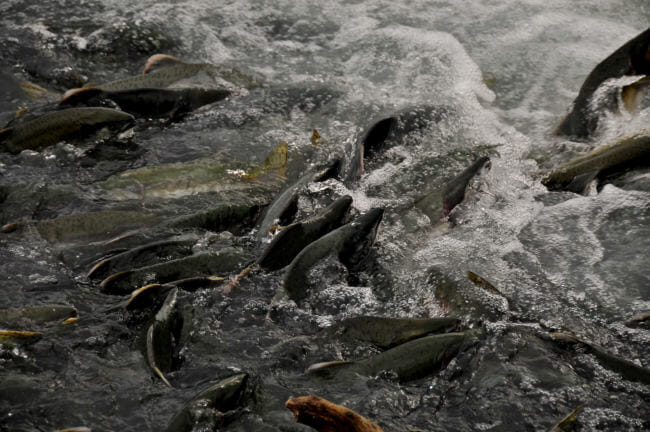
A ballot initiative aimed at protecting Alaska’s salmon habitat is kicking up a controversy. Environmental groups call it a needed step to protect Alaska’s most iconic — and lucrative — fish. But the state, many industry groups and several Alaska Native corporations are speaking out against it.
If Alaskans are confused about what the ballot initiative would actually do, that’s understandable. Both sides can’t seem to agree on how it would affect future development in Alaska.
At a Stand for Salmon event held in Anchorage this fall, supporter Arlo Davis collected his first signature from Kevin Illingworth.
As he signed on, Illingworth said like a lot of Alaskans, he thinks protecting salmon should be a priority.
“I know the importance of salmon to our entire state — not just any one group or individual, but to all of us,” Illingworth said.
Illingworth’s signature is just one of 32,127 Stand for Salmon’s organizers need to pin down before mid-January to get it on the ballot. That’s not the only hurdle. The state thinks the initiative is unconstitutional and is challenging it in court.
Here are some basics: Salmon habitat in Alaska is extensive, so the initiative assumes all the state’s water bodies are habitat for salmon and other, similar fish species, unless proven otherwise. If a project will significantly impact salmon habitat, it’s put through a much tougher vetting process by the Alaska Department of Fish and Game. Also, the state could require the public to weigh in before permitting a project.
And importantly, the initiative gives the state more power to stop projects altogether.
Industry groups hate the initiative.
“We don’t believe this initiative is standing for salmon at all. We think it’s shutting down the state economy, communities and our way of life,” Deantha Crockett, with the Alaska Miners Association, said at a recent conference.
Other industries and Native corporations banding against the initiative use similar language, saying it will set “near-impossible new standards” for development.
Take a big proposed mining project like the Pebble Mine or the Donlin Mine. Those mines are in areas with salmon habitat, which isn’t unusual in Alaska.
“Probably most large mines are going to somehow impact fish habitat and that’s unavoidable,” Richard Mylius said. Mylius, former director of the Alaska Department of Natural Resources’ Division of Mining Land and Water, is against the initiative.
In some cases, Mylius said a mine’s impact is permanent. According to legal documents filed by the state, the Donlin mine will eliminate two fish streams — forever.
“When you’re creating a permanent facility that’s always going to be there, you can’t mitigate that specific stream or restore that specific stream, because it’s not there anymore,” Mylius said.
But Mylius added that companies can’t just walk away and do nothing about it. Today, the state makes them compensate by restoring salmon habitat somewhere else, sometimes in a different water body.
The Stand for Salmon initiative would tighten the rules — all restoration, mitigation or preservation has to be in the same water body that’s damaged. If that’s not possible, then the project can’t go forward.
“Far away projects in other areas can’t compensate for the loss of function to the local community,” Valerie Brown of Trustees for Alaska, a legal organization supporting the initiative, wrote in an email.
Opponents say that’s one reason why Stand for Salmon is designed to block big projects like Donlin, but it will also impede smaller ones, like airstrips and roads.
But Stand for Salmon’s backers say this is an overreaction.
“If you actually do take a hard look at this and keep an open mind, you’ll see that this shift is not going to be dramatic — it’s not going to dramatically impact the way you can and do business,” Emily Anderson of the Wild Salmon Center said. Anderson helped write the initiative.
Anderson argued that in many cases, project builders can avoid permanently damaging salmon streams, like by putting a mine in a slightly different spot or by using different technology. But Anderson also acknowledged that under the initiative, some projects won’t make the cut.
“There’s a standard in here — a standard of care that says, ‘if you’re going to substantially damage Alaska’s fisheries, Fish and Game can say no to your permit,’” Anderson said.
Anderson called this is a paradigm shift for Alaska — but she said it’s an important one.
“There has to be some sort of upper limit or upper threshold and the ability built into the system for the state to say, ‘you know, this isn’t going to work with us,’” Anderson said.
But there’s another significant wrinkle to this controversy — a legal wrinkle. Stand for Salmon’s lawyers and the state’s lawyers fundamentally disagree on whether the initiative goes against the state’s constitution. The question is, does it mean that one state resource — salmon — would take priority over minerals, oil, hydropower and all Alaska’s other resources?
The Alaska Supreme Court will have the final word on that this spring. If the initiative wins in court and gets enough signatures, next year, it will be on the ballot.
Elizabeth Harball is a reporter with Alaska's Energy Desk, covering Alaska’s oil and gas industry and environmental policy. She is a contributor to the Energy Desk’s Midnight Oil podcast series. Before moving to Alaska in 2016, Harball worked at E&E News in Washington, D.C., where she covered federal and state climate change policy. Originally from Kalispell, Montana, Harball is a graduate of Columbia University Graduate School of Journalism.




